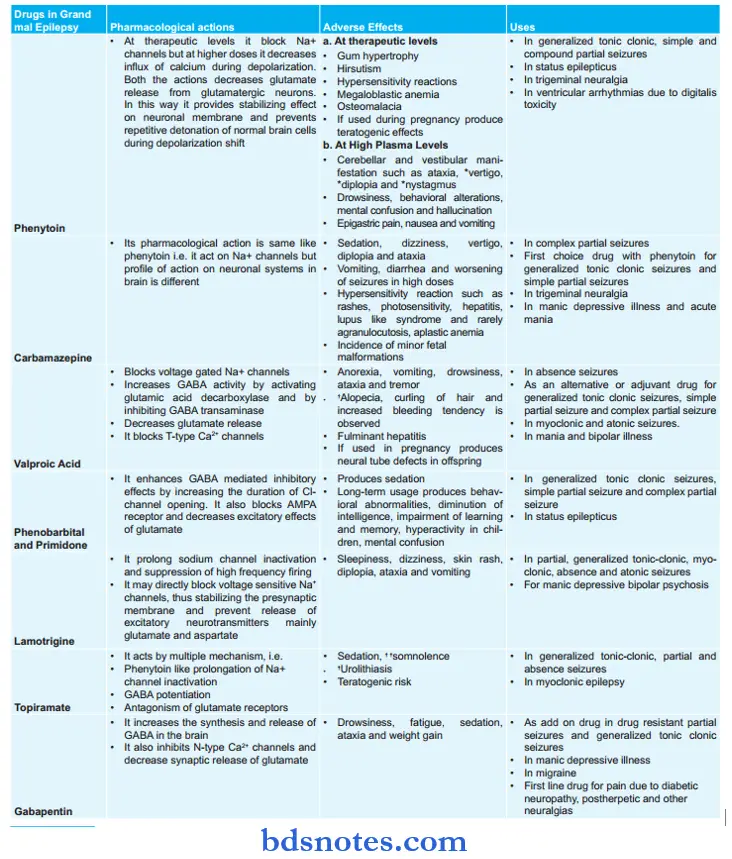Antiepileptic Drugs
Question 1. Write Short Notes On Phenytoin. And It’s Pharmacological Action And Adverse Effects. Classify AntiEpileptic Drugs.
Answer:
Phenytoin is a diphenylhydantoin.
Phenytoin Mechanism Of Action
Phenytoin stabilizes the neuronal membrane and prevents the spread of seizure discharge. Phenytoin delays the recovery of sodium ion channels from inactivated state and decreases the excitability of neurons.
At its high concentration phenytoin stop calcium ion influx in neuron and decreases glutamate levels and enhances response to GABA.
Read And Learn More: Pharmacology Question And Answers
Phenytoin Pharmacological Actions
- CNS actions: It has antiepileptic actions without causing drowsiness or sedation. It is not a CNS depressant.
- CVS: It has a membrane-stabilizing effect.
- At higher doses, it shows zero order kinetics.
- It induces hepatic microsomal enzymes.
Phenytoin Adverse Reactions or Phenytoin Side Effects
1. Phenytoin leads to dose-dependent toxicity which leads to the following side effects:
- Hyperplasia and hypertrophy of gums.
- Hypersensitivity reaction, i.e. urticaria, rashes, and lymphadenopathy.
- Hirsutism, acne, and coarsening of facial features.
- Hyperglycemia can occur due to decreased secretion of insulin.
- Hypocalcemia occurs due to decreased absorption of calcium from the gut.
- Megaloblastic anemia can occur due to folate deficiency.
- Osteomalacia occurs due to an increase in the metabolism of vitamin D.
- Fetal hydantoin syndrome occurs when used in pregnancy.
2. . In high concentration phenytoin can lead to:
- CNS: On chronic therapy, the vestibulocerebellar syndrome can occur.
- CVS: On IV administration it may cause hypotension and cardiac arrhythmias.
- GIT: Nausea, vomiting, and dyspepsia.
Phenytoin Uses
- Phenytoin is used in grand mal epilepsy.
- It is used in partial epilepsy.
- It is used in status epilepticus, trigeminal neuralgia, and cardiac arrhythmia.
Phenytoin Drug Interaction
- Phenobarbitone inhibits phenytoin metabolism.
- Phenytoin increases the degradation of digitoxin, folate, and oral contraceptive.
Question 2. Give An Account Of Adverse Reaction Of Phenytoin.
Answer:
1. Phenytoin leads to dose-dependent toxicity which leads to the following side effects:
Phenytoin Toxicity
- Hyperplasia and hypertrophy of gums.
- Hypersensitivity reaction, i.e. urticaria, rashes, and lymphadenopathy.
- Hirsutism, acne, and coarsening of facial features.
- Hyperglycemia can occur due to decreased secretion of insulin.
- Hypocalcemia occurs due to decreased absorption of calcium from the gut.
- Megaloblastic anemia can occur due to folate deficiency.
- Osteomalacia occurs due to an increase in the metabolism of vitamin D.
- Fetal hydantoin syndrome occurs when used in pregnancy.
2. In high concentration phenytoin can lead to:
- CNS: On chronic therapy, vestibulocerebella syndrome can occur.
- CVS: On IV administration it may cause hypotension and cardiac arrhythmias
Question 3. Write A Short Note On Carbamazepine.
Answer:
It is an anti-epileptic drug.
Carbamazepine Mechanism Of Action
- It modifies maximal electroshock seizures as well as raises the threshold to pentylenetetrazol and electroshock convulsions and prolongs inactivated state of the sodium ion channel
- It has an antidiuretic action, probably by enhancing ADH action on renal tubules.
Carbamazepine Pharmacokinetics
It is absorbed slowly and erratically from the gastrointestinal tract, binds to plasma proteins, and is well distributed in the body including CSF. It is metabolized in the liver. One of its metabolites has anticonvulsant activity. Repeated usage leads to enzyme induction and decreases the effectiveness of the drug itself.
Carbamazepine Adverse Effects
- It produces dose-related neurotoxicity, i.e. sedation, dizziness, vertigo, diplopia, and ataxia.
- Vomiting, diarrhea, and worsening of seizures are also seen with higher doses.
- Acute intoxication causes coma, convulsions, and cardiovascular collapse.
- Hypersensitivity reactions are rashes, photosensitivity, etc.
Carbamazepine Uses
- It is the most effective drug for complex partial seizures.
- It is used as a first-choice drug with phenytoin for generalized tonic-clonic seizures and simple partial seizures.
- It is a choice of drug in trigeminal and related neuralgia.
- It has a therapeutic effect on mood disorders.
- It is used in diabetes insipidus.
Question 4. Write Pharmacological Basis Of Use Of Carbamazepine In Epilepsy.
Answer:
It is the drug of first choice in epilepsy. Carbamazepine blocks the use of dependent sodium channels and inhibits high-frequency repetitive firing of the neurons in the brain at therapeutic doses and prevents epilepsy.
Question 5. Enumerate The Drugs Used In The Treatment Of Epilepsy.
Or
Write A Short Note On AntiEpileptics.
Answer:
Antiepileptic Drugs
Antiepileptic Drugs List – Drugs used in the treatment of Epilepsy:
- Barbituarate: Phenobarbitone
- Deoxybarbiturate: Primidone
- Hydantoin: Phenytoin, fosphenytoin
- Iminostilbene: Carbemazepine, oxcarbazepine
- Succinimide: Ethosuximide
- Aliphatic Carboxylic Acid: Valproic acid, Divalproex
- Benzodiazepines: clonazepam, diazepam, lorazepam, clobazam
- Phenyltriazine: Lamotrigine
- Cyclic GABA Analogue: Gabapentin
- Newer Drugs: Vigabatrin, topiramate, tiagabine, zonisamide, levetiracetam.
Since phenytoin is an anti-epileptic drug.
Question 6. Describe The Pharmacological Actions, Adverse Effects, And Uses Of Drugs Used In GrandMal Epilepsy.
Or
Write A Short Note On AntiEpileptics.
Answer:

Question 7. Explain why diazepam is used in the status epilepticus.
Answer:
Drug Of Choice For Status Epilepticus
Diazepam is a typical intravenous dosage of 5 to 10 mg per minute terminates seizures of any type in patients with status epilepticus. The mechanism of action is, Diazepam is a positive allosteric modulator of the GABA type A receptors (GABA-A).
The GABA-A receptors are ligand-gated chloride-selective ion channels that are activated by GABA (Gamma amino butyric acid), the major inhibitory neurotransmitter in the brain.
The binding of diazepam to this receptor complex promotes the binding of GABA, which in turn increases the total conduction of chloride ions across the neuronal cell membrane.
This increased chloride ion influx hyper-polarizes the neuron’s membrane potential. As a result, the difference between resting potential and threshold potential is increased and firing is less likely.

Leave a Reply